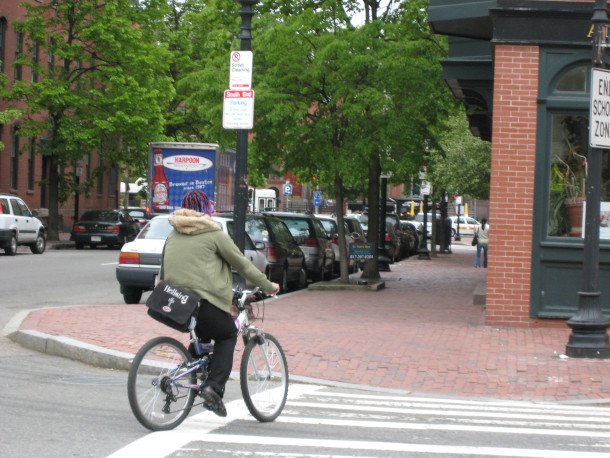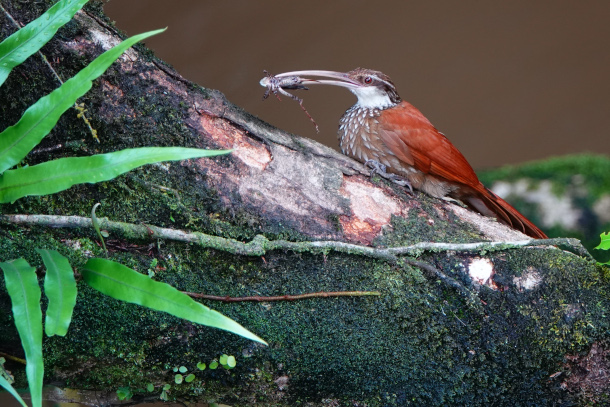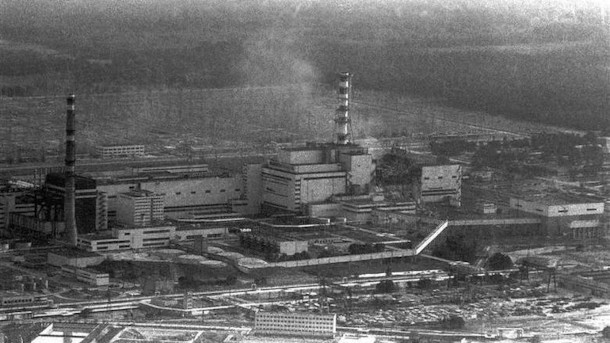Beyond the Headlines
Air Date: Week of February 4, 2022

A cyclist crosses the road in Boston, one of the top cities for cycling growth cited by a bicycle advocacy group. (Photo: Design for Health, Flickr, CC BY 2.0)
For this week's trip beyond the headlines with Environmental Health News Editor Peter Dykstra, he joins Host Bobby Bascomb to tally up the best cities for bicyclists in the United States. After that, the two look into why Amazonian birds appear to be shrinking over time. And, from the history books, 52 years ago ground was broken for the Chernobyl Nuclear Power Plant.
Transcript
CURWOOD: It’s Living on Earth, I’m Steve Curwood.
BASCOMB: And I’m Bobby Bascomb
Well, it's that time of the show again for a trip beyond the headlines with Peter Dykstra. Peter's an editor with Environmental Health News. That's EHN.org. And DailyClimate.org. Hey there, Peter, what do you have for us this week?
DYKSTRA: Hi, Bobby. There's a report from a nonprofit called the League of American Bicyclists. They cite five US cities where bike commuting is beginning to boom.
BASCOMB: Hmm. And what are those cities?
DYKSTRA: Well, we're gonna do a little guessing game with the audience here. While we talk this up for a minute, see if you can guess whether your town is on the list, or how many cities and towns you know, that would be bicycle-commuter friendly.
BASCOMB: Okay, well, let's give our listeners a little more information to go on. What makes a city or a town a boomtown for biking?
DYKSTRA: A lot of long-term planning, a little money, possibly more coming through the infrastructure bills as pushed by President Biden. But obvious things like bike lanes and streets, dedicated bike paths with no vehicle traffic, clearly marked pavement, pavement that's redone at least every 10 years. And the last one is access from bike lanes and paths to commuter trains and buses. I mean, those are all no brainers, but they're no brainers, here's your last hint, in mostly college towns.
BASCOMB: Ah ha, okay, well, I'm gonna guess at least one of them has to be Boston. I've been a bike commuter in Boston, and I think they've done a really good job of it. And it's only gotten better in the last five to 10 years or so.
DYKSTRA: Well, Boston tops the list. So you guessed right on that one. Additional cities include Chicago, the only city on the list that doesn't have a heavy, heavy presence as a college town. The others are Austin, Texas, Oakland, California, and Missoula, Montana.
BASCOMB: Missoula, Montana. That sounds surprising for some reason, I wouldn't have thought of it anyway.
DYKSTRA: Well, a bit like Boston, you don't expect a town that often has two feet of snow on the ground to be on a good list for bicycling.
BASCOMB: Yeah, yeah. Well, what else do you have for us this week?
DYKSTRA: Reports from the Amazon, that climate change may actually have a role in shrinking the size and weight of Amazonian birds.
BASCOMB: Hmm, what's going on there? Why are birds getting smaller in the Amazon?

A long-billed woodcreeper nabs an insect for a snack in the Amazon. (Photo: Valentin, Flickr, CC BY-NC 2.0)
DYKSTRA: It may be a chain reaction in the ecosystem, with climate affecting insects. When there are fewer insects, the birds that tend to be getting smaller, largely involve birds that feed on insects on or near the rainforest floor. And those are the ones that are experiencing reductions of up to 2% over the last few decades, and the birds that can't compete with other birds are species that in the long run may be doomed.
BASCOMB: Well, we know that insects are in decline everywhere in the world. Seems unfortunately that the Amazon is no exception to that. Well, what do you have for us from the history books this week?
DYKSTRA: February 4, 1970, ground is broken for the Chernobyl nuclear station. That's a complex north of Kiev, in what was a part of the Soviet Union, is now the independent as far as we know, nation of Ukraine. The plant's first reactor started up seven years later in 1977. But it was the fourth reactor, in 1986, that exploded and burned in the worst nuclear power accident known to have occurred in history.

Chernobyl’s fourth reactor, seen here in 1982, four years before the explosion in 1986. (Photo: Joker345, Wikimedia Commons, CC BY-SA 4.0)
BASCOMB: Wow, wow. Yeah, it sort of seems like something in the distant past. But it's really not all that long ago. And, of course, we're still dealing with the repercussions of it. They are locally, anyway.
DYKSTRA: They are and it may also play a role in any speculated invasion of Ukraine by Russia. President Putin, of course, has played it close to the vest in terms of whether or not Russia will invade. If they do and they go for the capital city of Kiev, their route to make that invasion would come from the north, and that would put Russian troops heading directly through the Chernobyl exclusion zone, a large area still considered to be contaminated and off limits. There are some intelligence reports that say that Russian troops in that area are decked out with radiological gear, protective gear, and the only reason that they might need protective gear for radiation is if they were going through a contaminated zone. The only one worth mentioning is Chernobyl.
BASCOMB: Mm hmm. Doesn't take much to connect the dots there then. All right, well, thanks, Peter. Peter Dykstra is an editor with Environmental Health News. That's EHN.org and DailyClimate.org. We'll talk to you again real soon.
DYKSTRA: Okay, Bobby, thanks a lot. Talk to you soon.
BASCOMB: And there's more in the stories on the Living on Earth website. That's LOE.org.
Links
Bloomberg CityLab | “5 U.S. Cities Where Bike Commuting Is Booming”
Discover Magazine | “Climate Change Might Be Shrinking Amazonian Birds”
Living on Earth wants to hear from you!
Living on Earth
62 Calef Highway, Suite 212
Lee, NH 03861
Telephone: 617-287-4121
E-mail: comments@loe.org
Newsletter [Click here]
Donate to Living on Earth!
Living on Earth is an independent media program and relies entirely on contributions from listeners and institutions supporting public service. Please donate now to preserve an independent environmental voice.
NewsletterLiving on Earth offers a weekly delivery of the show's rundown to your mailbox. Sign up for our newsletter today!
 Sailors For The Sea: Be the change you want to sea.
Sailors For The Sea: Be the change you want to sea.
 The Grantham Foundation for the Protection of the Environment: Committed to protecting and improving the health of the global environment.
The Grantham Foundation for the Protection of the Environment: Committed to protecting and improving the health of the global environment.
 Contribute to Living on Earth and receive, as our gift to you, an archival print of one of Mark Seth Lender's extraordinary wildlife photographs. Follow the link to see Mark's current collection of photographs.
Contribute to Living on Earth and receive, as our gift to you, an archival print of one of Mark Seth Lender's extraordinary wildlife photographs. Follow the link to see Mark's current collection of photographs.
 Buy a signed copy of Mark Seth Lender's book Smeagull the Seagull & support Living on Earth
Buy a signed copy of Mark Seth Lender's book Smeagull the Seagull & support Living on Earth

